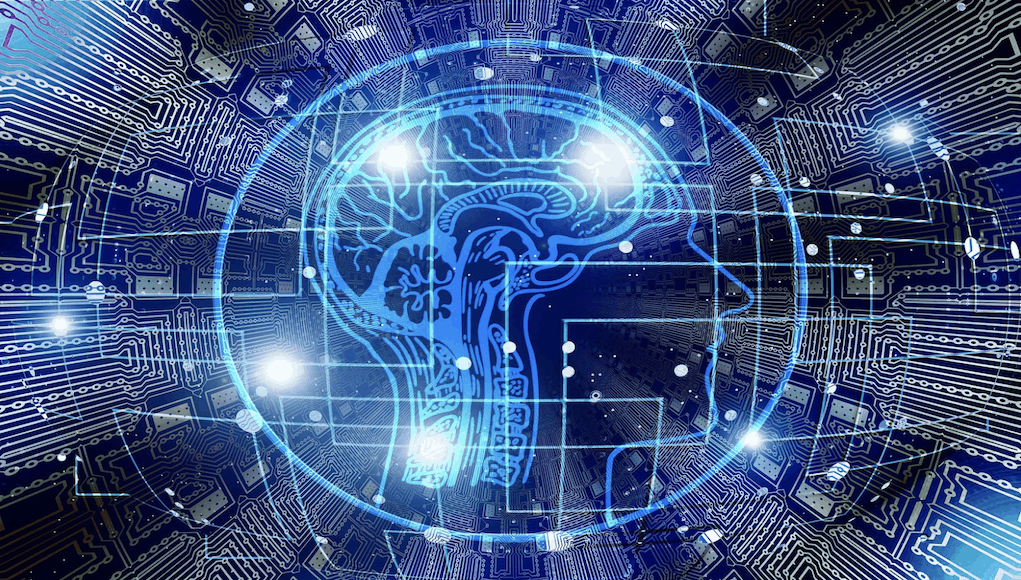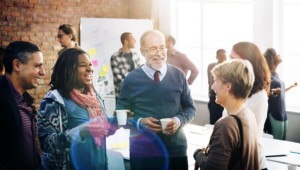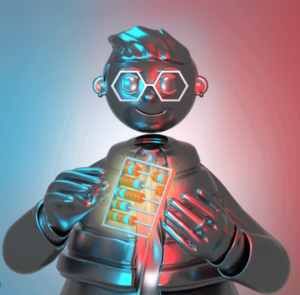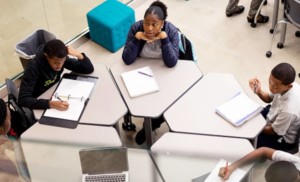Preparing All Learners for an Uncertain Future of Work

By: Katherine Prince
Continuous learning, cultural awareness, change expertise, adaptable and effective communication and the ability to learn from failure. These are just some of the capabilities that participants in KnowledgeWorks’ convenings on the future of work identified as being important for graduates. Finding resources to solve problems, time and project management, reflective leadership and a sense of responsibility to the broader community also promised to help all young people thrive no matter what future of work emerges.
That question – what future of work will emerge – is unanswerable, making it critical to help young people, along with other education and employment stakeholders, plan for multiple possible futures. From today’s vantage point, we can identify two critical drivers of change shaping the future of readiness for further learning, work and life: the rise of smart machines and the decline of full-time employment. But we cannot yet know what extent of technological unemployment we will face or how much support individuals will have in navigating the changing employment landscape.
A New Foundation for Readiness
In face of such uncertainties, stakeholders need to help people develop our uniquely human attributes along with developing flexible skills that we can apply across settings. Putting social-emotional skill development at the center of learning promises to help individuals develop the foundation necessary to navigate uncertainty throughout their lives. The new foundation for readiness shown below illustrates how redefining readiness from the inside out – focusing on human development rather than attempting to prepare learners for any particular future of work – can provide a platform for future success.
This new foundation for readiness is grounded in the human qualities that are most central to our relationships with one another and which are most difficult to code. Social-emotional skill development will need to be supported in integrated ways alongside the mastery of content and the application of skills and knowledge to specific contexts. Education institutions will need to balance supporting learners in preparing for their first-careers while also helping them develop the adaptability and resilience needed to navigate the changing economy and the ways of thinking necessary to address complex problems.
Flipping Education’s Focus
Establishing a new focus on feeling and relating will help education institutions and systems align with a future of readiness in which foundational skills and practices will be more important and enduring than specific content or job- and task-related skills.
For K-12 education, flipping the focus of learning to whole-person development could mean that:
- Curriculum needs to be inverted, with core social-emotional competencies shaping the design of inquiry projects and the school and classroom rituals that anchor the learning climate and culture.
- Students need to be grouped in new ways to follow flexible learning pathways.
- Classrooms need to become more fluid and open, enabling new ways of structuring learning.
- School schedules need to be transformed to allow for more interdisciplinary collaboration, deep reflection and personalized learning.
- Educators’ roles need to be reconfigured to focus less on content or grade specialization and more on foundational skills and practices, as well as on interdisciplinary, phenomenological or challenge-based learning.
- Community partners need to become key assets for introducing new kinds of learning experiences that stretch students’ comfort zones and expand their aspirations.
- K-12 schools and districts need to explore where and when it may be more appropriate for them to serve as brokers, rather than direct providers, of learning experiences.
At the postsecondary level, institutions might need to:
- Focus more on supporting deep personal development as well as context- and discipline-specific skills and knowledge.
- Diversify offerings and business models, with a multitude of formats and structures engaging learners and increasing access.
- Contribute to student-driven and student-designed ecosystems of support that evolve over time and reflect students’ strengths, weaknesses and needs.
- Help students plan for both their careers and their lives and respond to changing conditions.
- Enable learners to weave in and out of learning experiences as their career development needs dictate.
- Collaborate more extensively with workplace partners.
- Shift the focus of faculty professional development toward supporting students’ development of foundational skills and practices and attaining ongoing learning related to relevant workplace skills.
Strategies for Redefining Readiness
The suggestions above reflect significant systemic and institutional shifts within education. Redefining readiness also requires many contributors to work across sectors in pursuit of comprehensive and coordinated strategies designed to prepare all people for possible future employment landscapes. Key levers include empowering people to bring about change, reorganizing educational and other structures to align with future needs and encouraging society to rethink approaches to readiness.
At the people level, empowering educator and curriculum innovation promises to help educators design learning experiences that will increase students’ readiness for work and life. Providing educators with the appropriate data, time, partnerships and support to engage in their own experiential learning, explore novel pedagogical approaches and develop curricular innovations can help them reorient learning around future readiness needs. Developing personalized approaches to learning and integrating career-pathway exploration can be part of such a shift. In addition, providing competency-based educational opportunities at both the K-12 and postsecondary levels can enable students to pull from real-world learning experiences to show that they have mastered desired skills. Workplaces can contribute by incorporating mentorship or other learning-support responsibilities into job descriptions at every level and by prioritizing their employees’ ongoing learning and professional development.
At the structural level, incenting partnership and alignment across sectors can help create more comprehensive and effective approaches to readiness. As the employment landscape changes and people need new types of education, training, reskilling and social supports, education and employment stakeholders must be able to engage in long-term collaborative relationships and find ways to increase readiness and well-being for people across their lifetimes. Developing a networked approach to lifelong learning can help learners access a wide variety of learning experiences and interact with experts. Drawing upon community resources – not just education systems and institutions – and working across traditional geographic boundaries can help make the redefinition of readiness a collaborative and cross-sector effort.
At the societal level, engaging people in broad and inclusive conversations about the changing nature of work and how education and employment stakeholders might prepare young people promises to build public will for change. We need to treat readiness as a social issue, not just an educational and employment challenge. As the nature of work, employer-provided benefits and opportunity changes, disparities and inequities could increase unless stakeholders take coordinated action to adjust the social infrastructure to reflect emerging realities. In addition, regional approaches to readiness need to respond to local circumstances and assets. Developing aspirational visions that leverage regions’ unique strengths, resources and values can help communities create signature learning ecosystems that support learners in thriving no matter what future of work emerges.
Supporting Future Readiness
As these possibilities highlight, supporting future readiness will involve working within and beyond today’s education systems and institutions. It will also involve prioritizing human development and situating learning in ways that enhance and extend opportunities. In addition to leading the way toward future readiness for further learning, work and life, education could play a leadership role in helping communities find new signature identities in the face of economic, demographic and climate-driven shifts.
For more, see:
- The Future of Learning: Redefining Readiness from the Inside Out
- Navigating the Future of Learning
- Commentary: In Our Changing Economy We Need New Flexible Education Systems to Usher in an Age of Agility for Tomorrow’s Workforce
Katherine Prince is Senior Director, Strategic Foresight at KnowledgeWorks, where she leads the exploration of the future of learning. Connect with her on Twitter: @katprince

This post is a part of the Getting Smart Future of Work Campaign. The future of work will bring new challenges and cause us to shift how we think about jobs and employability — so what does this mean for teaching and learning? In our exploration of the #FutureOfWork, sponsored by eduInnovation and powered by Getting Smart, we dive into what’s happening, what’s coming and how schools might prepare. For more, follow #futureofwork and visit our Future of Work page.
Stay in-the-know with innovations in learning by signing up for the weekly Smart Update.




0 Comments
Leave a Comment
Your email address will not be published. All fields are required.